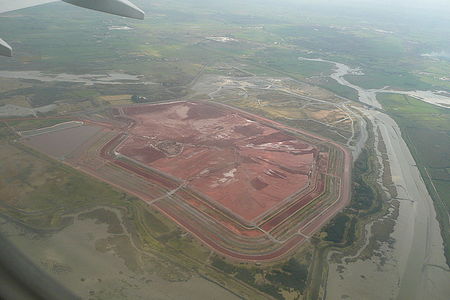Red Mud and Bio-Oil

Red Mud
Red Mud is a by-product/waste that derives from the alumina producing industries (during the Bayer process for alumina production). It is composed of a mixture of solid and metallic oxide-bearing impurities, and presents one of the aluminium industry's most important disposal problems. The red color is caused by the iron oxides, which can make up to 60 percent of the mass of Red Mud. In addition to iron, the other dominant particles include silica, unleached residual aluminium, and titanium oxide. Red Mud cannot be disposed of easily. Based on an Australian report, "the inventory was 2.7Bt at 2007, growing at a rate of 119 Mt per year". In most countries where Red Mud is produced, it is pumped into holding ponds. Red Mud presents a problem as it takes up land area and can neither be built on nor farmed, even when dry. It is estimated that around 1.5 tons of red mud will be generated for every 1 ton of alumina produced. In October of 2010, a huge reservoir of Red Mud collapsed in western Hungary, flooding three villages and killing several people.
Red Mud and Bio-Oil
While searching for a way to produce higher-grade heating fuel from agricultural and forestry biomass, U of Guelph chemist Marcel Schlaf discovered a technique that might make good use of red mud in the processing of bio-oil. The high acidity of bio-oil makes it unstable, corrosive and very difficult to store. Tests by Schlaf and post-doc Elham Karimi were successful in lowering the acid level of the organic liquid and producing higher-grade oil. The same process changes red mud itself into a neutral magnetic material that is no longer caustic and toxic but that could be used as a building material.
Apparently, Prof. Schlaf wants this technology to be open source, non-patentable !!! Hats off to the man, this is what the world needs. Here is an email he sent to many collaborators and other interested parties:
Original Message----- From: Marcel Schlaf [mailto: ... uoguelph.ca] Sent: Wednesday, January 20, 2010 9:48 PM To: [deleted] Cc: [deleted] Subject: Public Disclosure: Upgrading of pyrolysis bio-oil using Red Mud and/or reduced Red Mud as the catalyst Dear Colleagues: For the purposes of patentability in the NAFTA, EU, Mercosur regions as well as India, China and Japan, the attached documents regarding the use of Red Mud (or reduced Red Mud) as a catalyst for the upgrading of pyrolysis bio-oil shall constitute a public disclosure effectively preventing the filing of patent for such or similar process in the listed jurisdictions. (Red Mud is understood to be the material obtained as the by-product of the Bayer process used in the refining of Bauxite to Al2O3) The documents (you don't have to read any of them ;-) ) consist of a Manuscript and Supporting Information recently submitted to Energy & Fuels (ACS) and a group meeting talk given by my post-doc Dr. Elham Karimi. The content lays out both the concept as well as the principal reduction to practice of the use of Red Mud as a bio-oil upgrading catalyst. Why am I doing this and why are you getting this email ? 1) Red Mud is produced at > 70 mio tons/year world-wide, is non-toxic but considered a waste by-product and essentially available for the cost of its transportation. 2) Pyrolysis bio-oil could in principle be produced on a megaton scale from non-food biomass using concentrated solar thermal energy. 3) Co-processing of bio-oil and Red Mud for the purpose of catalytic upgrading of the oil to a usable fuel (for cooking, turbine, heating, engines) could also be carried out using concentrated solar thermal energy. Our initial/preliminary results look promising and if ultimately successful, I would like to the see the potentially emerging technology used in developing countries with complete freedom to operate and without royalty payments to anyone - this means: NO PATENTS. Vision: Make fuel from ligno-cellulosic biomass using sunshine and Red Mud in rural Burundi, Bangladesh, Paraguay ... You have received this email, because you are in some way connected to the chemical and/or oil industry or are in fact yourself active in the field of biomass conversion or Red Mud valorization. Your comments are welcome, if you wish to express them. I would like to take this opportunity to thank Rio Tinto Alcan (Jonquiere, Quebec) for making an authentic Red Mud sample available to our laboratory and the Agricultural Bioproducts Innovation Network (ABIN - Agriculture Canada) for funding our work. Cheers, Marcel Marcel Schlaf, Dipl.-Chem., Ph.D.
In India, Red Mud is produced at a rate of about *4 MT/yr* and is disposed as a slurry having a solid concentration in the range of 10-30%, pH in the range of 13 and high ionic strength and contains silica, aluminum, iron, calcium, titanium, as well as an array of minor constituents, namely: Na, K, Cr, V, Ni, Ba, Cu, Mn, Pb, Zn etc. Uses: make building bricks and tiles, lightweight structural blocks, roofing sheets, as an additive to concrete, paint, wood substitute, glass, ceramic flyash/redmud polymer door shutters, furniture, flooring and panelling work, electrical switch boxes and insulating sheets etc. (ex. by making red mud jute fibre polymer composites (RFPC))